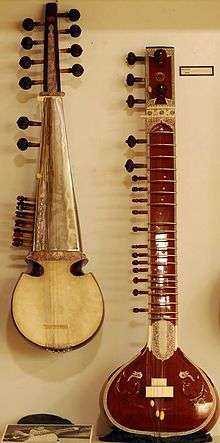Nadaswaram

| Carnatic music |
|---|
Tanjavur-style Tambura |
| Concepts |
| Compositions |
| Instruments |
|
The nadaswaram, nagaswaram, nadhaswaram or nathaswaram (Tamil:நாதஸ்வரம்), is a double reed wind instrument. It is a traditional classical instrument originated in Tamil Nadu and also used in Andhra Pradesh, Karnataka, and Kerala (India).
This instrument is "among the world's loudest non-brass acoustic instruments".[1] It is a wind instrument similar to the North Indian shehnai but much longer, with a hardwood body and a large flaring bell made of wood or metal.
In Tamil culture, the nadaswaram is considered to be very auspicious, and it is a key musical instrument played in almost all Hindu weddings and temples of the South Indian tradition.[2] It is part of the family of instruments known as mangala vadya[3] (lit. mangala ["auspicious"], vadya ["instrument"]). The instrument is usually played in pairs, and accompanied by a pair of drums called thavil;[4] it can also be accompanied with a drone from a similar oboe called the ottu.[5]
History
Nadaswaram is referred in many ancient Tamil texts. Silappatikaram refers to an instrument called "vangiyam". The structure of this instrument matches that of Nadaswaram. Since there are seven holes played with seven fingers this was also called as "Ezhil". This instrument, too, is widely played in Tamil Nadu and popular among the Tamil Diaspora.
Construction
The nadaswaram contains three parts namely, kuzhal, thimiru, and anasu.
It is a double reed instrument with a conical bore which gradually enlarges toward the lower end. The top portion has a metal staple (mel anaichu) into which is inserted a small metallic cylinder (kendai) which carries the mouthpiece made of reed. Besides spare reeds, a small ivory or horn needle is attached to the instrument, and used to clear the reed of saliva and other debris and allows free passage of air. A metallic bell (keezh anaichu) forms the bottom end of the instrument.
Traditionally the body of the nadaswaram is made out of a tree called aacha (Tamil ஆச்சா; Hindi अंजन), although nowadays bamboo, sandalwood, copper, brass, ebony and ivory are also used. For wooden instruments, old wood is considered the best, and sometimes wood salvaged from demolished old houses is used.[6]
The nadaswaram has seven finger-holes, and five additional holes drilled at the bottom which can be stopped with wax to modify the tone.[7] The nadaswaram has a range of two and a half octaves, similar to the Indian bansuri flute, which also has a similar fingering. Unlike the flute where semi and quarter tones are produced by the partial opening and closing of the finger holes, in the nadaswaram they are produced by adjusting the pressure and strength of the air-flow into the pipe. Due to its intense volume and strength it is largely an outdoor instrument and much more suited for open spaces than for indoor concerts.
Players
Some of the greatest early nadaswaramists include
- Karukurichi Arunachalam Pillai
- Thiruvavadudurai Rajaratnam Pillai,
- Thiruvengadu Subramania Pillai,
- Thiruvenkadu Subramania Pillai,
- Thirucherai Sivasubramanian Pillai
- Andankoil A V Selvarathnam Pillai
- Thiruvizha Jayashankar
- Thiruveezhimizhalai V.N. Rameshkumar,
- Brother teams of Keeranur and Thiruveezhimizhalai,
- Semponnarkoil Brothers S R G S Vasanthakumar and Mohandoss.
- Semponnarkoil Brothers S R G Sambandam and Rajanna.
- Dharumapuram S. Abiramisundaram Pillai and his son Dharumapuram A Govindarajan [8]
- Sheik Chinna Moulana
- Namagiripettai Krishnan
- Injikudi E.M. Subramaniam
American composers such as Lewis Spratlan[9] have expressed admiration for the nadaswaram, and a few jazz musicians have taken up the instrument: Charlie Mariano (b. 1923) is one of the few non-Indians able to play the instrument,[10] having studied it while living in India. Vinny Golia, J. D. Parran, and William Parker have performed and recorded with the instrument. The German saxophonist Roland Schaeffer also plays it,[11] having studied from 1981 to 1985 with Karupaia Pillai.
Picture Gallery
-
Nadaswaram
See also
References
- ↑ "Reality show India's Got Talent - Khoj 2 winners to sing for Obama". India Today. 31 October 2010. Retrieved 9 January 2012.
- ↑ Light Isaac (1967). Theory of Indian music. Printed at Shyam Printers. p. 156. Retrieved 25 December 2012.
- ↑ Vijaya Ghose; Jaya Ramanathan; Renuka N. Khandekar (1992). Tirtha, the treasury of Indian expressions. CMC Ltd. p. 201. ISBN 978-81-900267-0-3. Retrieved 25 December 2012.
- ↑ Percussioner International Audio Magazine. Sal Sofia Industries, Inc. 1984. p. 38. Retrieved 25 December 2012.
- ↑ Ragini Devi (1990). Dance Dialects Of India. Motilal Banarsidass Publ. pp. 222–. ISBN 978-81-208-0674-0. Retrieved 25 December 2012.
- ↑ "Indian Instruments : [http://www.vijaytamil.tv/ Nadaswaram] | Indian Music : Getting to know a little more about Indian music, musicians and instruments". aboutindianmusic.com. 2011-11-22. Retrieved 2012-01-09. External link in
|title=(help) - ↑ O. Gosvami (1 January 1961). The story of Indian music: its growth and synthesis. Scholarly Press. p. 156. ISBN 978-0-403-01567-2. Retrieved 25 December 2012.
- ↑ Andankoil AV Selvarathnam PillaiB. Kolappan (2010-12-15). "Arts / Music : An art that's still awaiting its due". The Hindu. Retrieved 2012-01-09.
- ↑ Sampath, Revathi (16 March 2008). "Nadaswaram". India Currents. Retrieved 2015-04-08.
- ↑ Ian Carr; Digby Fairweather; Brian Priestley (2004). Jazz: The Essential Companion to Artists and Albums. Rough Guides. pp. 99–. ISBN 978-1-84353-256-9. Retrieved 25 December 2012.
- ↑ Saxophone Journal. Dorn Publications. 1988. p. 46. Retrieved 25 December 2012.
External links
- Images from The Beede Gallery Shawms (Ottu and Nagaswaram), Southern India, ca. 1900-1940. National Music Museum, University of South Dakota.
